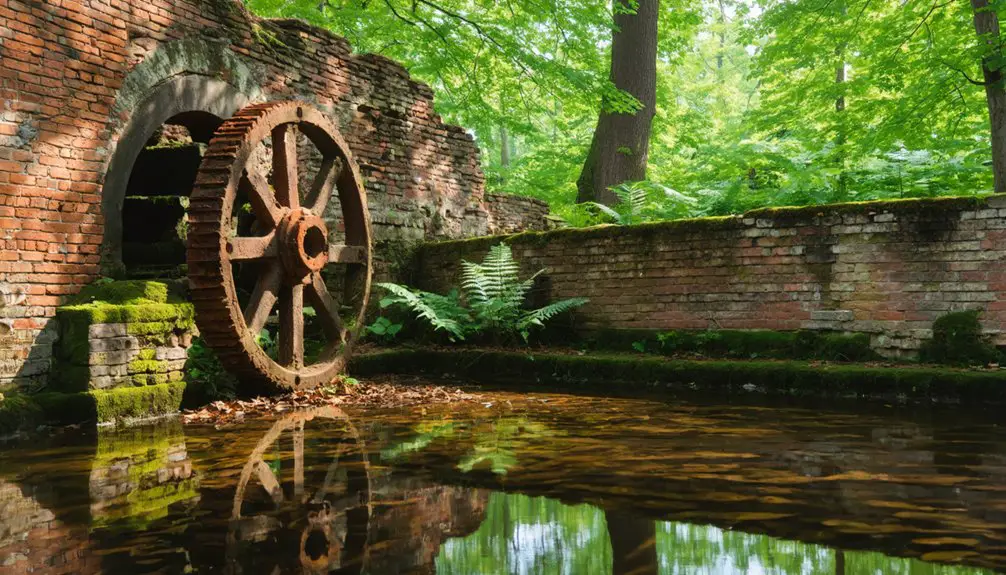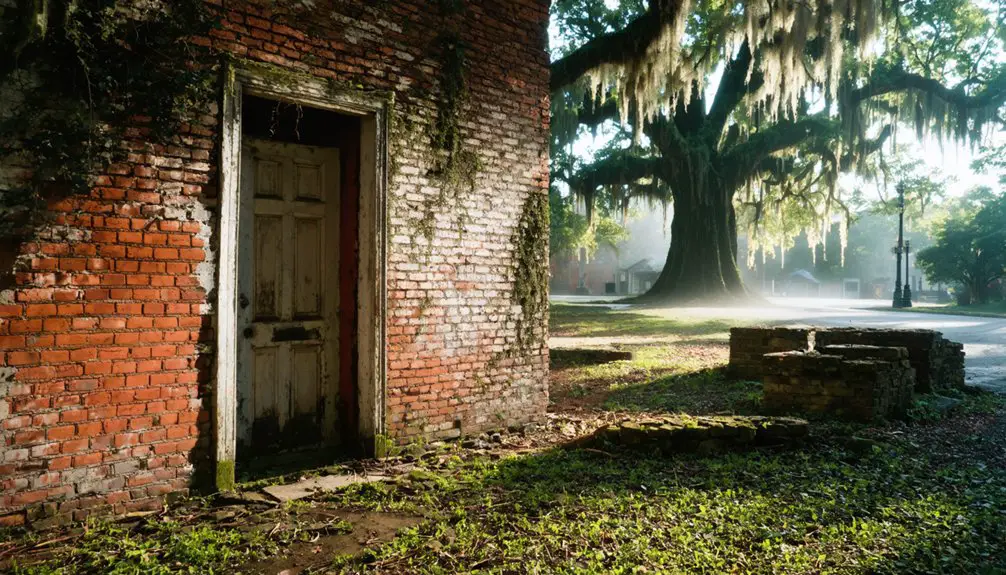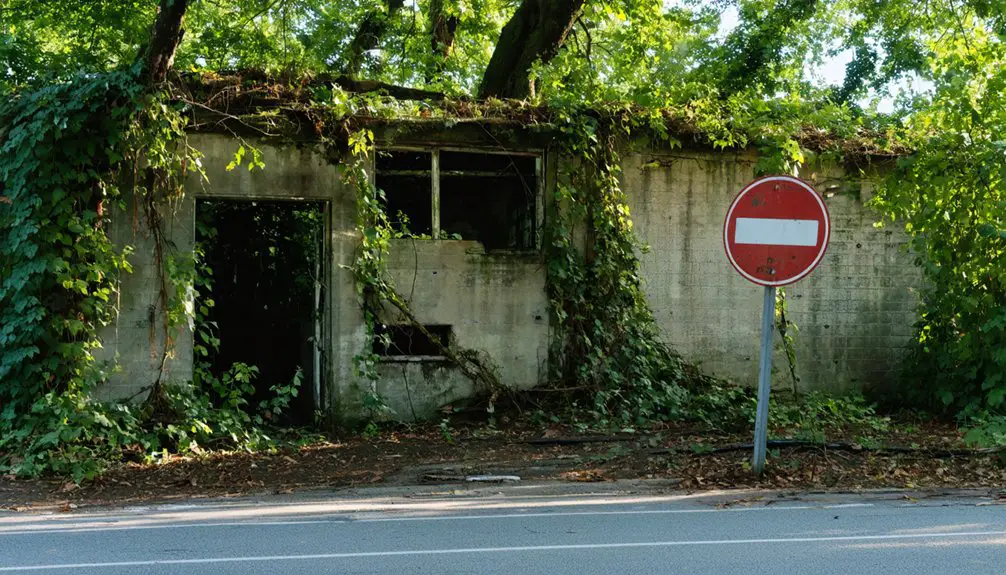You’ll find the haunting remains of America’s first ironworks at Falling Creek in Chesterfield County, Virginia. This pioneering industrial site, established in 1619, produced up to 600 tons of iron annually until its destruction during the 1622 Powhatan uprising. Today, the preserved 97-acre site features archaeological ruins, interpretive trails, and educational displays that tell the story of colonial innovation and tragedy along the James River. The site’s underwater artifacts hold even more secrets beneath the surface.
Key Takeaways
- Falling Creek became abandoned after the 1622 Powhatan attack destroyed the ironworks and killed its workers.
- The settlement was North America’s first iron production site, operating from 1619 until its destruction in 1622.
- Archaeological remains show industrial infrastructure including waterwheels, forges, and original timber structures from the colonial period.
- The site’s strategic location near James River and abundant natural resources initially supported a thriving industrial community.
- Today, the preserved 97-acre site features historical trails and educational displays commemorating the abandoned settlement’s history.
America’s First Ironworks: A Pioneer Industrial Site
The Falling Creek Ironworks stands as a symbol of early American industrial ambition. In 1619, you’d have found this groundbreaking facility nestled at the meeting point of Falling Creek and the James River in Virginia. As the first iron production site in North America, it marked your colony’s bold step toward self-sufficiency.
You would’ve seen early technology at work: blast furnaces transforming local bog ore into cast iron, while water-powered bellows and forge hammers shaped metal into tools and hardware. After its destruction, Virginia relied on European iron imports for over a century.
The operation was extensive, with charcoal kilns consuming vast forest acreage to fuel the works. This industrial pioneer supplied essential iron goods to colonial settlements like Henricus, Williamsburg, and Jamestown, though its promising start was cut short by the devastating Powhatan attack of 1622. The precise location of the ironworks remained a mystery until erosion exposed furnace timbers in the early 21st century.
The Devastating Powhatan Attack of 1622
On March 22, 1622, a devastating blow shattered the promising future of Falling Creek Ironworks and numerous other English settlements along the James River. Opechancanough, the Pamunkey headman, orchestrated a coordinated surprise attack across fifty miles of territory to push back against English expansion into native lands.
You’ll find that Powhatan warriors, disguised as traders, entered settlements unarmed before releasing destruction with seized English weapons and tools.
At Falling Creek, like many other sites, the Powhatan motivations were clear – to regain control and sovereignty over their territory. The attack came after eight years of peace between the English colonists and the Powhatan Chiefdom. Chief Powhatan’s death had led to a shift in tribal leadership and policy toward the settlers.
The settlement consequences proved severe, as the ironworks facility was completely destroyed. Workers were killed, buildings burned, and the site was abandoned.
This attack, which claimed up to 400 colonial lives, forced surviving settlers to retreat to fortified locations near Jamestown.
Archaeological Discoveries Along the James River
After centuries of uncertainty about its precise location, archaeological excavations at Falling Creek’s confluence with the James River have revealed the remains of North America’s first iron production facility.
You’ll find evidence of massive industrial infrastructure, including waterwheels, blast furnaces, and forges spread across 3.5 acres of historic ground.
Underwater archaeology along the James River has uncovered colonial artifacts that tell the story of early American commerce.
Beneath the James River’s surface lies a treasure trove of colonial artifacts, revealing the rich tapestry of America’s early trading history.
Most significantly, divers discovered a five-foot-long anchor from the 19th century, proving the river’s lasting importance as a trade route.
The Rice Rivers Center now offers hands-on education in underwater archaeological methods, connecting you directly to this rich heritage.
Recent flood events have exposed original timber structures, giving you a glimpse into the engineering prowess of Virginia’s earliest industrialists.
Chesterfield Forge operated on the site from 1750 until its destruction by Benedict Arnold in 1781.
The tragic March 22, 1622 attack resulted in the deaths of 27 colonists and the complete destruction of this pioneering industrial site.
Natural Resources and Colonial Development
While archaeological findings reveal the industrial heritage of Falling Creek, its natural landscape held remarkable advantages for colonial development.
You’ll find that early settlement patterns concentrated around this strategic location where Falling Creek meets the James River, offering vital access to shipping routes and natural resources essential for industrial growth.
Three key elements made Falling Creek perfect for resource management:
- Rich deposits of high-quality bog iron ore discovered in 1608
- Dense forests providing abundant wood for charcoal production
- Swift creek waters powering mechanical operations for ironworks
These natural advantages drew 150 ironworkers and their families to establish America’s first iron production facility in 1619, marking a significant shift toward colonial self-sufficiency beyond agriculture. In 1744, the area experienced renewed industrial growth with the establishment of the first blast furnace in North America.
The site’s resources supported both industrial ambitions and sustainable settlement growth until the devastating Powhatan attack of 1622.
The location’s proximity to the Fall Line rapids made it an ideal spot for early colonial manufacturing and trade operations.
Modern Legacy and Historical Preservation
Since its establishment in 1991, the Falling Creek Ironworks Foundation has spearheaded preservation efforts for America’s first ironworks site, partnering with Chesterfield County to protect this essential piece of colonial heritage.
You’ll find extensive community engagement through annual commemorative events and educational initiatives that connect visitors to Virginia’s industrial roots. The site’s history includes the tragic March 22, 1622 attack that resulted in the deaths of nearly all workers and the destruction of the original Iron Works. Early operations reached impressive production levels of 600 tons annually during its peak period.
The foundation’s work has expanded from 14.6 acres to over 97 acres of preserved parkland, featuring new interpretive signage, improved trails, and planned museum facilities.
Archaeological discoveries, including the 1999 confirmation of the blast furnace location and exposed 18th-century timbers, continue to reveal the site’s historical significance.
The area’s centerpiece, the 1824 Falling Creek Bridge, stands as Virginia’s first wayside park, though it faces ongoing preservation challenges from natural elements.
Frequently Asked Questions
What Other Ghost Towns Exist Near Falling Creek in Virginia?
Like shadows of America’s past, you’ll find Port Warwick, Henricus, Warwick, and Elko Tract haunting the Richmond area near Falling Creek, while Howrytown and Hickory Ridge whisper forgotten tales nearby.
How Did Local Wildlife Populations Change After the Ironworks Closed?
You’ll notice wildlife adaptation accelerated as forests regrew and pollution decreased. Deer, birds, and aquatic species flourished, while the ecological impact showed nature’s resilience through improved habitat connectivity.
Were There Any Paranormal Stories Associated With Falling Creek’s Abandoned Site?
You won’t find documented ghost sightings at this site – despite Virginia’s rich haunted locations nearby. While locals might whisper about eerie feelings around the old ironworks ruins, no verified paranormal stories exist.
What Happened to the Survivors’ Descendants After the 1622 Massacre?
You’ll find survivor stories showing many descendants rebuilt lives in fortified settlements, with families like the Keetons and Jordans establishing lasting Virginia legacies despite facing epidemics, famine, and continued conflicts.
Did Confederate Forces Use Falling Creek’s Location During the Civil War?
The writing’s on the wall – you’ll find Confederate forces didn’t establish major bases at Falling Creek, though they leveraged its strategic location near James River and railroads for Civil War supply routes.
References
- https://en.wikipedia.org/wiki/Falling_Creek_Ironworks
- https://www.chesterfield.gov/facilities/facility/details/Falling-Creek-Ironworks-Park-79
- https://encyclopediavirginia.org/11555-abdcc34480f693f/
- https://en.wikipedia.org/wiki/Falling_Creek
- https://www.chesterfield.gov/156/History
- http://www.virginiaplaces.org/ggs380/10iron.html
- https://experiencechesterfield.com/blog/history-happened-here-falling-creek-ironworks/
- https://research.colonialwilliamsburg.org/Foundation/journal/Autumn07/iron.cfm
- https://research.colonialwilliamsburg.org/foundation/journal/Autumn05/tyme.cfm
- https://vascw.org/cool_timeline/second-anglo-powhatan-war/



